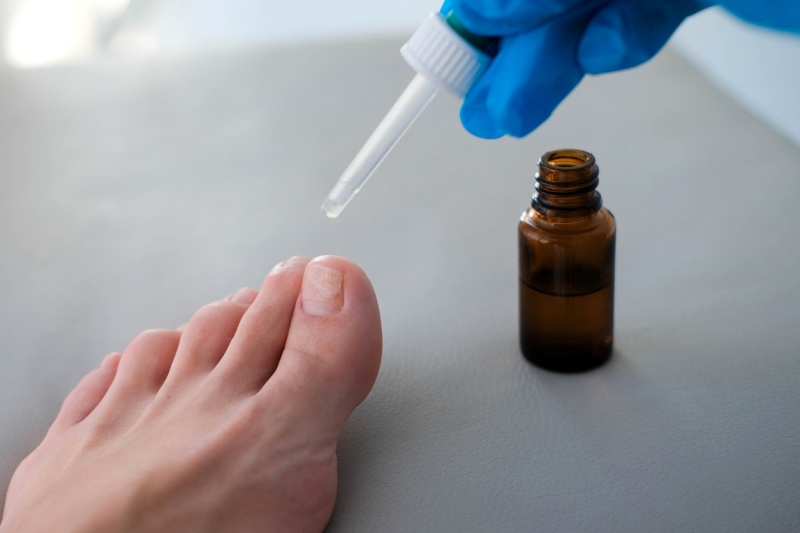Mānuka oil stands out as a highly effective natural remedy for combating fungal infections, thanks to its remarkable abundance of triketones.
Mānuka oil has a broad range of therapeutic applications. It can provide relief from conditions involving pain, including rheumatism, muscle and joint pain, and arthritis. Additionally, skin issues such as dandruff, acne, eczema, and psoriasis, can benefit from its antifungal and antiseptic properties. Mānuka oil is also effective against bacterial and fungal problems such as athlete’s foot, nail fungus, and body odour.
What Is Mānuka Oil?

Mānuka oil, derived from the leaves and twigs of the mānuka tree native to New Zealand, possesses potent anti-fungal properties that make it a valuable natural remedy for various fungal infections. These properties stem from the oil’s unique chemical composition, which includes β-triketones, such as leptospermone and iso-leptospermone, along with other bioactive compounds.
Unlike many synthetic antifungal products, mānuka oil is an entirely natural pure, potent oil, making it a safe and eco-friendly option.
Mānuka Oil’s Antifungal Properties
Mānuka oil’s anti-fungal properties are attributed to its complex mixture of bioactive compounds, including β-triketones and sesquiterpenes, which act through various mechanisms to combat fungal infections effectively. Whether used for toenail fungus, athlete’s foot, ringworm, or other fungal conditions, mānuka oil’s natural and potent anti-fungal capabilities make it a valuable asset in the holistic healthcare and skincare industry.
Activity of Mānuka Oil Against Fungi that Cause Skin & Soft Tissue Disease
| Organism | MIC % | Relevance |
| C. glabrata | 0.010 | Vaginal infections |
| C. albicans | 0.015 | Oral and genital thrush, jock itch, nappy rash |
| T. Rubrum | <0.039 – 0.30 | Athletes foot, nail infections |
| T. mentagrophytes | 0.05 – 0.08 | Tinea infections |
| Malassezia furfur | 1.56 | seborrheic dermatitis, tinea versicolor |
| T. mucoides | 1.56 | Infection of the hair shaft, systemic infections |
| M. canis | <0.039 | Alopecia, scaling, lesions |
The Minimum Inhibitory Concentration (MIC) is a crucial measure in microbiology, representing the lowest concentration of an antimicrobial substance required to prevent visible growth of a microorganism after an overnight incubation period. MICs are highly regarded as the “gold standard” for evaluating the susceptibility of microorganisms to antimicrobial agents.
In practical terms, a lower MIC value indicates that a smaller quantity of the antimicrobial substance is needed to effectively inhibit the growth of the target microorganism. Consequently, essential oils with lower MIC scores are considered more potent and efficient as antimicrobial agents in combating microbial growth.
The table above demonstrates mānuka oil’s ability to achieve a lower MIC score suggesting its potency in combating fungal infections. Furthermore, the results emphasise the importance of considering mānuka oil as a reliable option when seeking treatments for fungal infections due to its demonstrated effectiveness in inhibiting fungal growth at lower concentrations.
The Power of Mānuka Oil in Fighting Fungal Infections

One of the remarkable features of mānuka oil is its ability to inhibit the growth and proliferation of a wide range of fungal species. It achieves this through multiple mechanisms of action. First, mānuka oil disrupts the fungal cell membranes, compromising their structural integrity and leading to cell death. This is particularly effective against fungi that have developed resistance to traditional antifungal agents.
Additionally, mānuka oil can interfere with fungal communication systems, known as “quorum sensing.” This disruption hinders the fungi’s ability to coordinate virulent activities, such as rapid multiplication and the secretion of toxins. Consequently, fungal infections become less severe, and their spread is curtailed.
Furthermore, some fungal species employ efflux pumps to expel antifungal agents and resist treatment. Mānuka oil has been shown to counteract this resistance mechanism by inhibiting efflux pumps in certain fungi. This action ensures that the fungi remain susceptible to treatment and prevents the development of resistance.
Mānuka Oil for Foot & Nail Fungus and Athlete’s Foot
Mānuka oil offers an effective natural solution for dealing with persistent toenail fungus and athlete’s foot. Unlike numerous topical creams, mānuka oils and ointments collaborate with the body to combat the fungus effectively. They have the capability to penetrate deeply into the nailbed.
To address toenail fungus, apply a few drops of mānuka oil directly to the affected nails or feet twice daily. Cover the area with fine cotton fabric or cotton socks for at least 30 minutes to facilitate oil absorption.
For severe athlete’s foot, apply the oil directly to the affected area once or twice a day for one week. Mānuka oil treatment effectively manages the infection, relieves itching and odour, and soothes the surrounding skin. Its antibacterial properties aid in healing and prevent the infection from spreading.
Toenail and athlete’s foot fungi thrive in warm, moist environments, often found inside shoes. To prevent reinfection, apply a few drops of mānuka oil to the interior leather near the affected areas of the foot or nails. It is also important to change socks daily and wash them with hot water.
Mānuka Oil for Ringworms
Ringworm is a contagious fungal infection that can impact the skin, hair, and nails. It is a common fungal skin infection that can be easily spread by contact with other people and pet cats and dogs.
It is most common amongst children and can be easily picked up from a family pet or from swimming pools.
Ringworm displays a characteristic ring shape with the outer edges slightly swollen as the infection spreads across the infected area.
Mānuka oil offers effective relief by soothing the affected area, accelerating the healing process of blemishes, reducing the population of fungi, and preventing its spread to other areas or individuals.
Mānuka Oil for Acne
Acne is a common skin condition that often results from the clogging of hair follicles and the proliferation of bacteria on the skin. Mānuka oil can be a natural and botanical solution for managing acne due to its remarkable antibacterial properties.
When applied topically, mānuka oil penetrates deeply into the skin’s pores. Its antibacterial components, such as β-triketones and sesquiterpenes, target the bacteria responsible for acne breakouts. By inhibiting bacterial growth, mānuka oil helps prevent the formation of new acne lesions and minimises the exacerbation of existing ones.
Moreover, mānuka oil’s natural anti-inflammatory properties can help reduce redness and swelling associated with acne. This soothing effect provides relief to individuals with inflamed and irritated skin.
Another beneficial aspect of mānuka oil in acne management is its ability to soften and loosen blackheads and whiteheads. By doing so, it facilitates the removal of these blemishes, preventing them from evolving into more severe forms of acne.
In essence, mānuka oil’s natural antibacterial properties make it an excellent choice for individuals dealing with acne-prone skin. It not only restricts bacterial growth but also aids in reducing inflammation and promoting the overall health of the skin.
Safety Measures In Using Mānuka Oil
When selecting the right mānuka oil product for treating fungal infections, it is essential to consider a patch test as part of one’s precautionary measures. While mānuka oil is generally safe for most individuals, conducting a patch test can help determine if there are any adverse reactions or allergies to the product. To perform a patch test, follow these steps:
- Choose a small, inconspicuous area on the skin, such as the inner forearm or behind the ear.
- Cleanse the chosen area gently and allow it to dry completely.
- Apply a small amount of the mānuka oil product to the test area.
- Cover the area with a bandage or adhesive patch.
- Leave the patch test in place for 24 hours.
- Check the test area for any signs of redness, itching, swelling, or irritation during and after the 24-hour period.
If there are any adverse reactions, such as skin irritation or an allergic response, discontinue the use of the mānuka oil product and consult a healthcare professional. If no adverse reactions occur during the patch test, the product is likely safe for use, but it is highly recommended to consult with a healthcare provider first, especially if the individual using the oil has underlying health conditions.

